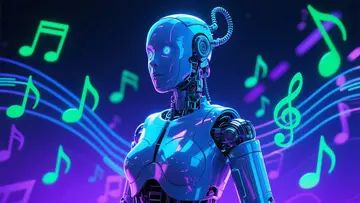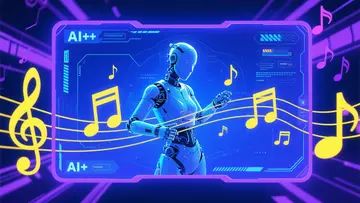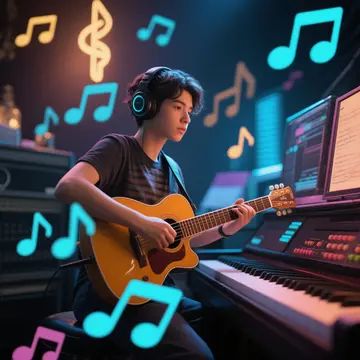Introduction: Can AI Music Artists Really Land Brand Deals?
In 2025, the lines between human and machine creators have blurred—and brands are paying attention. Virtual influencers like Lil Miquela and Noonoouri, alongside AI music projects powered by Suno, Udio, and Boomy, are not just releasing tracks—they’re signing sponsorship deals, appearing in campaigns, and generating ROI for real-world companies.
So the burning question is:
How can AI music artists secure brand collaborations?
And more importantly, what does it take for an AI act to be brand-worthy?
This article dives deep into the strategies AI music creators, managers, and developers can use to position their virtual artist for meaningful, monetizable brand partnerships—across fashion, gaming, cosmetics, tech, and more.

Why Brands Are Interested in AI Music Artists
AI music artists offer something unique that traditional influencers often can't:
24/7 availability and controllability
Highly customizable aesthetic and brand voice
No risk of personal scandals or off-brand behavior
Global scalability across languages, markets, and platforms
Integration across multimedia formats (AR, VR, animation, music, short-form video)
With tools like Runway ML, Synthesizer V, Kaiber, and ElevenLabs, creators are building AI personas with their own songs, personalities, and fanbases. These artists, once niche, are now brand-ready avatars.
What Makes an AI Music Artist Attractive to Brands?
To collaborate with real-world brands, an AI music artist needs more than just cool visuals. Here’s what labels and marketing managers look for:
1. Authentic Brand Identity
Does the AI artist have a distinct persona or message?
Is the character consistent across platforms (TikTok, Instagram, YouTube)?
Can the persona naturally align with certain industries (e.g., fashion, tech, wellness)?
?? Example: Noonoouri’s luxury aesthetic made her a fit for Dior and Balenciaga campaigns.
2. Platform Presence and Engagement
Is the AI artist actively publishing content on TikTok, Reels, or YouTube Shorts?
Are the songs trending or being used in user-generated content?
Are there engaged followers and organic comments (even small but loyal)?
?? AI creators like Ghostwriter977 leveraged viral TikTok momentum to build brand interest—even with anonymous personas.
3. Cultural Relevance and Niche Appeal
Is the AI artist aligned with Gen Z, gaming, EDM, lo-fi, or anime aesthetics?
Can they reflect values like inclusivity, digital innovation, or sustainability?
How to Prepare Your AI Music Artist for Brand Collaborations
Step 1: Craft a Consistent Digital Persona
Whether your AI artist is a futuristic cyberpop icon or a lo-fi bedroom producer, consistency is key.
Use design tools like Midjourney, D-ID, or Leonardo AI for visuals
Generate artist voiceovers with ElevenLabs or PlayHT
Combine music from Suno or Boomy to form an original catalog
Build social posts with CapCut, Adobe Express, or Canva Video
The goal: A fully integrated character that audiences—and brands—can believe in.
Step 2: Build a Social Content Engine
Brands want visibility. Show them you can get it.
Upload 3–5 short-form videos per week
Use trending TikTok sounds, challenges, or stitching formats
Embed the AI artist’s music into videos—even better if it’s an original track
Engage with followers using comments written in character voice
Tip: AI singers with distinctive voices (from Suno or Udio) can sync lip animations using tools like Papercup or Kaiber AI.
Step 3: Collaborate with Micro-Creators
Even if your AI artist doesn’t have 100K followers, collaborations can spark exposure.
Partner with micro-influencers who use your track in UGC
Offer duets, virtual appearances, or “in-character” interviews
Use platforms like Collabstr or Famebit to find brand-friendly creators
Some brands notice early when they see an AI act cross-pollinating with real communities.
Step 4: Pitch to Brand Marketing Teams
Once your AI artist has:
At least 1,000–5,000 engaged followers
A portfolio of 5–10 videos or branded moments
A Press Kit or Media Deck (PDF or Linktree format)
It’s time to reach out.
Pitch directly to:
Brand partnership leads at companies (LinkedIn works!)
Music licensing managers (especially for AI-friendly platforms like Epidemic Sound)
Marketing agencies working with brands in your target niche
Make sure your pitch includes:
What your AI artist stands for
Who their audience is
Sample videos or song placements
What kinds of collaborations you envision (e.g., jingle creation, product placement, virtual events)
Real-World Examples of Brand Collaborations with AI Artists
1. Noonoouri x Warner Music + Dior
A fashion-forward virtual artist with AI vocals, Noonoouri secured a record deal and appeared in multiple high-end fashion campaigns.
2. FN Meka x Capitol Records + Tech Brands
Despite backlash, the project showed that AI rappers could generate brand buzz. Lessons: tread carefully, and make your AI persona culturally aware.
3. Lil Miquela x Prada, Calvin Klein, Samsung
Although not strictly an AI music artist, Lil Miquela's crossover into music helped land collaborations across industries due to her unique blend of art, activism, and tech appeal.
Types of Brand Collaborations AI Music Artists Can Pursue
Product Placements: AI artist wears a brand’s fashion or mentions tech in lyrics
Sponsored Content: Co-create TikToks or music videos featuring a brand's messaging
Branded Music Creation: Compose and release theme songs or ad tracks
Virtual Concerts: Perform branded sets in metaverse platforms or via livestream
NFT or AR Collabs: Launch limited-edition collectibles tied to a campaign
FAQ: Brand Collaborations for AI Musicians
Q1: Do brands accept AI-only creators?
Yes, especially in fashion, tech, gaming, and Web3. The key is a strong, consistent persona.
Q2: Do I need a big following?
Not necessarily. Niche engagement can be more valuable than raw follower counts.
Q3: Can AI music be used in brand campaigns legally?
Yes—if you own the rights to the music generated by platforms like Suno or Boomy (check licensing terms carefully).
Q4: How do I price a brand collaboration?
Start with content package pricing (e.g., $100–$1000 for small brands), then scale with performance metrics like reach, shares, and conversions.
Q5: Should I use a manager or agency?
If you're serious about monetization and growing fast, a virtual talent agency or digital music manager can help open doors faster.
Conclusion: AI Music Artists Can Be Brand Ambassadors Too
In 2025, brands are no longer asking “Is this artist human?”
They’re asking:
“Can this artist tell our story, resonate with our audience, and bring value?”
With the right visual identity, sonic consistency, and social momentum, your AI music artist can land paid brand collaborations just like real-world musicians—sometimes even more effectively.
The future is synthetic, scalable, and strategic. Now is the perfect time to build your AI artist’s media kit and start pitching.
Learn more about AI MUSIC


